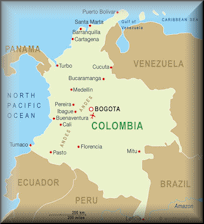-
-

Please Wait...
-
.co Colombian Domain Country Information - .co Colombia Country Information
.co

Price and Requirements for .co Domains
Registration Pricing
- 1 Year 29.95 USD
- 2 Years 59.90 USD
- 3 Years 89.85 USD
- 4 Years 119.80 USD
- 5 Years 149.75 USD
Application Fee
Registration Time Frame
Instant
Requirements
Yes Details Are Individual .co domain registrations allowed?
Yes Details Company or legal entities registrations allowed for .co?
No Details Are there requirements, documents, or information needed for .co?
Yes Details Are some .co domain names restricted?
Yes Details Does .co domain have a special use?
No Details Other information I need to know about .co?
No Details Are there any additional fees for .co?
No Details Do I need a trademark/brand name to register .co?
Yes Details WHOIS Privacy service available?
![]() Trustee / Proxy service offered? Fees?
No
Details
Trustee / Proxy service offered? Fees?
No
Details
.co Colombia Country Information
Colombia, officially the Republic of Colombia, is a unitary constitutional republic comprising thirty-two departments. The country is located in northwestern South America, bordered to the east by Venezuela and Brazil; to the south by Ecuador and Peru;[ to the north by the Caribbean Sea; to the northwest by Panama; and to the west by the Pacific Ocean. Colombia has maritime borders with Venezuela, Jamaica, Haiti, the Dominican Republic, Honduras, Nicaragua and Costa Rica. Colombia is the 26th largest country by area and the 27th largest by population, and the third largest in South America after Brazil and Argentina. With over 46 million people, Colombia has the second largest population of any Spanish-speaking country in the world, after Mexico. It is also the only country in South America having coasts in the Pacific Ocean and in the Atlantic Ocean. Colombia is a middle power, with the fourth largest economy in Latin America, and the third largest in South America.
The territory of what is now Colombia was originally inhabited by indigenous peoples including the Muisca, Quimbaya, and Tairona. The Spanish arrived in 1499 and initiated a period of conquest and colonization ultimately creating the Viceroyalty of New Granada (comprising modern-day Colombia, Venezuela, Ecuador, north-western Brazil and Panama), with its capital at Bogotá. Independence from Spain was won in 1819, but by 1830 "Gran Colombia" had collapsed with the secession of Venezuela and Ecuador. What is now Colombia and Panama emerged as the Republic of New Granada. The new nation experimented with federalism as the Granadine Confederation (1858), and then the United States of Colombia (1863), before the Republic of Colombia was finally declared in 1886. Panama seceded in 1903.
Colombia was the first constitutional government in South America, and the Liberal and Conservative parties, founded in 1848 and 1849, are two of the oldest surviving political parties in the Americas. However, tensions between the two have frequently erupted into violence, most notably in the Thousand Days War (1899–1902) and La Violencia, beginning in 1948. Since the 1960s, government forces, left-wing insurgents and right-wing paramilitaries have been engaged in the continent's longest-running armed conflict. Fueled by the cocaine trade, this escalated dramatically in the 1980s. Since 2000 the violence has decreased significantly, with many paramilitary groups demobilising as part of a controversial peace process and the guerrillas losing control of much of the territory they once dominated. Meanwhile Colombia's homicide rate almost halved between 2002 and 2006. As of 2011 Colombia remains the world's largest producer of cocaine, although production has been falling. According to the Institute for Economics and Peace Colombia is the most violent nation in Latin America as of 2011. In 2010, tourism in Colombia increased 11% according to UNWTO Tourism Highlights for that year.
Colombia is very ethnically diverse, and the interaction between descendants of the original native inhabitants, Spanish colonists, Africans brought as slaves and twentieth-century immigrants from Europe and the Middle East has produced a rich cultural heritage. This has also been influenced by Colombia's varied geography. The majority of the urban centres are located in the highlands of the Andes mountains, but Colombian territory also encompasses Amazon rainforest, tropical grassland and both Caribbean and Pacific coastlines. Ecologically, Colombia is one of the world's 17 megadiverse countries, and is considered the most megadiverse per square kilometer.
The geography of Colombia is characterized by containing five main natural regions that present their own unique characteristics, from the Andes mountain range region shared with Ecuador and Venezuela; the Pacific Ocean coastal region shared with Panama and Ecuador; the Caribbean Sea coastal region shared with Venezuela and Panama; the Llanos (plains) shared with Venezuela; to the Amazon Rainforest region shared with Venezuela, Brazil, Peru and Ecuador. Colombia is the only South American country which borders both the Atlantic and Pacific Oceans.
Colombia is bordered to the east by Venezuela and Brazil; to the south by Ecuador and Peru; to the north by Panama and the Caribbean Sea; and to the west by Ecuador and the Pacific Ocean. Including its Caribbean islands, it lies between latitudes 14°N and 5°S, and longitudes 66° and 82°W
.co Colombia Domain Name - Country Information
| Country Domain | Colombia Domain Name .co |
|---|---|
| Country Information | Colombia Domain Country Information .co |
| TLD Bulk & Advanced Search | Colombia Bulk Domain Registration .co |
| WhoIs Server | .co Whois Server Information |
| Domain Renewals | Renewal Colombian Domain .co |
| Domain Transfer | Transfer Domain .co |
| Domain Hosting | .co Colombia Web Hosting |
| SSL Certificates | SSL Certificates |
| Email Services | .co Colombia Email Services |
| Domain FAQ | .co Domain Registration FAQ |
Colombia Country Information Search Terms
Colombian Domain Country Information Colombian Domain Registrar Colombian World Wide Domain Registration Colombian Country Code Top Level Domain .co Domain Information Colombian Country Information Colombia Country Information














